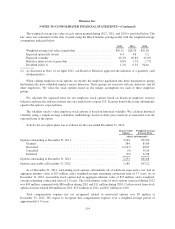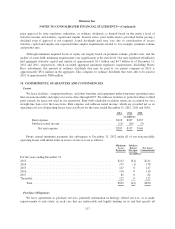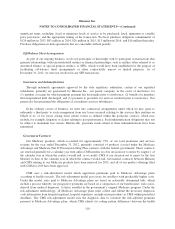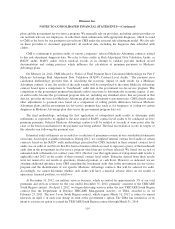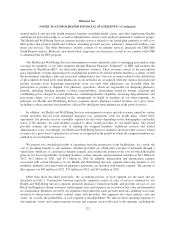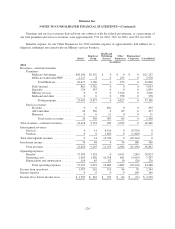Humana 2012 Annual Report Download - page 132
Download and view the complete annual report
Please find page 132 of the 2012 Humana annual report below. You can navigate through the pages in the report by either clicking on the pages listed below, or by using the keyword search tool below to find specific information within the annual report.Humana Inc.
NOTES TO CONSOLIDATED FINANCIAL STATEMENTS—(Continued)
insured medical and specialty health insurance benefits, including dental, vision, and other supplemental health
and financial protection products, as well as administrative services only products marketed to employer groups.
The Health and Well-Being Services segment includes services offered to our health plan members as well as to
third parties that promote health and wellness, including provider services, pharmacy, integrated wellness, and
home care services. The Other Businesses category consists of our military services, primarily our TRICARE
South Region contract, Medicaid, and closed-block long-term care businesses as well as our contract with CMS
to administer the LI-NET program.
Our Health and Well-Being Services intersegment revenues primarily relate to managing prescription drug
coverage for members of our other segments through Humana Pharmacy Solutions®, or HPS, and includes the
operations of RightSourceRx®, our mail order pharmacy business. These revenues consist of the prescription
price (ingredient cost plus dispensing fee), including the portion to be settled with the member (co-share) or with
the government (subsidies), plus any associated administrative fees. Services revenues related to the distribution
of prescriptions by third party retail pharmacies in our networks are recognized when the claim is processed and
product revenues from dispensing prescriptions from our mail order pharmacies are recorded when the
prescription or product is shipped. Our pharmacy operations, which are responsible for designing pharmacy
benefits, including defining member co-share responsibilities, determining formulary listings, selecting and
establishing prices charged by retail pharmacies, confirming member eligibility, reviewing drug utilization, and
processing claims, act as a principal in the arrangement on behalf of members in our other segments. As
principal, our Health and Well-Being Services segment reports pharmacy related revenues on a gross basis,
including co-share amounts from members collected by third party retail pharmacies at the point of service.
In addition, our Health and Well-Being Services intersegment revenues include revenues earned by certain
owned providers derived from risk-based managed care agreements with our health plans. Under these
agreements, the provider receives a monthly capitated fee that varies depending on the demographics and health
status of the member, for each member assigned to these owned providers by our health plans. The owned
provider assumes the economic risk of funding the assigned members’ healthcare services and related
administrative costs. Accordingly, our Health and Well-Being Services segment reports provider services related
revenues on a gross basis. Capitation fee revenue is recognized in the period in which the assigned members are
entitled to receive healthcare services.
We present our consolidated results of operations from the perspective of the health plans. As a result, the
cost of providing benefits to our members, whether provided via a third party provider or internally through a
stand-alone subsidiary, is classified as benefits expense and excludes the portion of the cost for which the health
plans do not bear responsibility, including member co-share amounts and government subsidies of $4.7 billion in
2012, $4.2 billion in 2011, and $3.5 billion in 2010. In addition, depreciation and amortization expense
associated with certain businesses in our Health and Well-Being Services segment delivering benefits to our
members, primarily associated with our pharmacy operations, are included with benefits expense. The amount of
this expense was $43 million in 2012, $33 million in 2011, and $18 million in 2010.
Other than those described previously, the accounting policies of each segment are the same and are
described in Note 2. Transactions between reportable segments consist of sales of services rendered by our
Health and Well-Being Services segment, primarily pharmacy, behavioral health, and provider services, to our
Retail and Employer Group customers. Intersegment sales and expenses are recorded at fair value and eliminated
in consolidation. Members served by our segments often utilize the same provider networks, enabling us in some
instances to obtain more favorable contract terms with providers. Our segments also share indirect costs and
assets. As a result, the profitability of each segment is interdependent. We allocate most operating expenses to
our segments. Assets and certain corporate income and expenses are not allocated to the segments, including the
122




